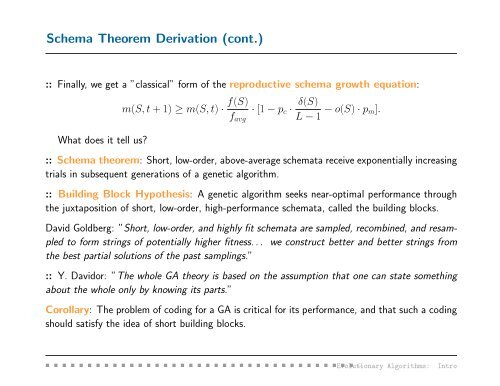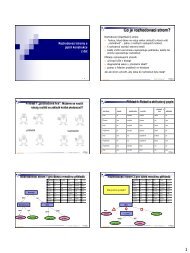Evolutionary Algorithms: Introduction Jiˇr´ı Kubal´ık Department of ...
Evolutionary Algorithms: Introduction Jiˇr´ı Kubal´ık Department of ...
Evolutionary Algorithms: Introduction Jiˇr´ı Kubal´ık Department of ...
Create successful ePaper yourself
Turn your PDF publications into a flip-book with our unique Google optimized e-Paper software.
pSchema Theorem Derivation (cont.)<br />
:: Finally, we get a ”classical” form <strong>of</strong> the reproductive schema growth equation:<br />
What does it tell us?<br />
m(S, t + 1) ≥ m(S, t) · f(S)<br />
favg<br />
· [1 − pc · δ(S)<br />
L − 1<br />
− o(S) · pm].<br />
:: Schema theorem: Short, low-order, above-average schemata receive exponentially increasing<br />
trials in subsequent generations <strong>of</strong> a genetic algorithm.<br />
:: Building Block Hypothesis: A genetic algorithm seeks near-optimal performance through<br />
the juxtaposition <strong>of</strong> short, low-order, high-performance schemata, called the building blocks.<br />
David Goldberg: ”Short, low-order, and highly fit schemata are sampled, recombined, and resampled<br />
to form strings <strong>of</strong> potentially higher fitness. . . we construct better and better strings from<br />
the best partial solutions <strong>of</strong> the past samplings.”<br />
:: Y. Davidor: ”The whole GA theory is based on the assumption that one can state something<br />
about the whole only by knowing its parts.”<br />
Corollary: The problem <strong>of</strong> coding for a GA is critical for its performance, and that such a coding<br />
should satisfy the idea <strong>of</strong> short building blocks.<br />
<strong>Evolutionary</strong> <strong>Algorithms</strong>: Intro











![RANSAC [Fischler, Bolles '81]](https://img.yumpu.com/17549294/1/190x143/ransac-fischler-bolles-81.jpg?quality=85)




